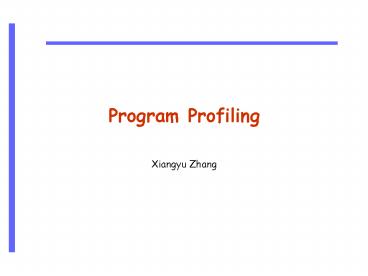Program Profiling - PowerPoint PPT Presentation
1 / 21
Title:
Program Profiling
Description:
foo's continuation. asynchronous foo(...) foo's body. foo's continuation ... between a method and its continuation are broken in the parallelized version. ... – PowerPoint PPT presentation
Number of Views:23
Avg rating:3.0/5.0
Title: Program Profiling
1
Program Profiling
- Xiangyu Zhang
2
Outline
- What is profiling.
- Why profiling.
- Gprof.
- Efficient path profiling.
- Object equality profiling
3
What is Profiling
- Tracing is lossless, recording every detail of a
program execution - Thus, it is expensive.
- Potentially infinite.
- Profiling is lossy, meaning that it aggregates
execution information onto finite entries. - Control flow profiling
- Instruction/Edge/Function Frequency
- Value profiling
- Value Frequency
4
Why Profiling
- Debugging
- Enable time travel to understand what has
happened. - Code optimizations
- Identify hot program paths
- Data compression
- Value speculation
- Data locality that help cache design
- Performance tuning
- Security
- Malware analysis
- Testing
- Coverage.
5
GNU gprof Profiler
- Gprof is a profiler for C programs.
- It profiles execution times for each individual
functions and produces a call graph with calling
edges annotated with frequencies. - Working
- Gcc with the p pg options. p tells the program
to save profiling information, and pg saves
debug information in the compiled executable. - Gcc instruments the entry and exit of each
function to record the calling frequency of each
function. - Sampling is used to measure execution time.
- inaccuracy
- A gmon.out file will be created at the end.
- Run gprof ./a.out to view the profilers
information.
6
More Advanced Path Profiling
- How often does a control-flow path execute?
- Levels of profiling
- blocks
- edges
- paths
400
A
57
343
B
C
D
E
F
7
Naive Path Profiling
buffer
A
put(A)
put(B)
B
C
put(C)
put(D)
D
E
F
put(F) record_path()
put(E)
8
Efficient Path Profiling
A
Path Encoding ABDEF 0 ABDF 1 ABCDEF 2 A
BCDF 3 ACDEF 4 ACDF 5
r 4
B
C
r 2
D
r 1
E
F
countr
9
Efficient Path Profiling
6
A
2
4
B
C
2
D
1
1
E
F
10
Efficient Path Profiling
6
A
2
4
B
C
2
D
1
1
E
F
countr
11
Path Regeneration
Given path sum P, which path produced it?
P 3
A
4
B
C
2
D
1
F
E
12
Handling Loops
A
r 2
B
r 8
r 2
r 3
C
D
r 3
r 2 countr r8
E
F
r 1
r 2
r 1
G
H
13
Overhead and Others
- EPP causes 40 overhead on average.
- The path explosion problem.
- If the number of paths is too large to enumerate,
which is not very uncommon, hash maps have to be
used. - Can be used to achieve efficient tracing.
- Reading assignment
- Efficient Path Profiling, by T. Ball and J.
Larus, Micro 1996 - The optimization (chord algorithm) is not
required.
14
Object Equality Profiling (OEP)
- OEP discovers opportunities for replacing a set
of equivalent object instances with a single
representative object. - Replacing an object x with an object y means
replacing all references to x by references to y. - Requires x and y have same field values.
- Object oriented programs typically create and
destroy large numbers of objects. Creating,
initializing and destroying an object consumes
execution time and also requires space for the
object while it is alive. - Many objects are identical
15
- In the white paper WebSphere Application Server
Development Best Practices for Performance and
Scalability. Four of the eighteen best
practices are instructions to avoid repeated
creation of identical objects (in particular,
Use JDBC connection pooling, Reuse data
sources for JDBC connections). - Merging objects reduces memory usage, improves
memory locality, reduces GC overhead, and reduces
the runtime costs of allocating and initializing
objects.
16
An Example
17
Mergability
- The objects are of the same class.
- Each pair of corresponding field values in the
objects is either a pair of identical values or a
pair of references to objects which are
themselves mergeable. - Neither object is mutated in the future.
- The objects have overlapping lifetimes.
18
Mergability Profiling
- The profiler produces triples ltclass, allocation
site, estimated savinggt - Information to collect
- Allocation times
- The last references
- Field values
19
Results
- Reduce the memory footprints of two SpecJVM
programs by 37 and 47. - In program DB, which is a database application
- entry.items.addElement (new String(buffer, 0, s,
e-s))
20
Challenge (1 extra credit)
- A recent trend to parallelize a sequential
program is to spawn a method call as a separate
thread.
asynchronous foo()
foo()
foos body
foos body
foos continuation
foos continuation
21
- Devise a profiler that identifies method calls
that are amenable to such parallelization. - Hint you ought to consider if dependences
between a method and its continuation are broken
in the parallelized version. - You can assume a dependence detector.

